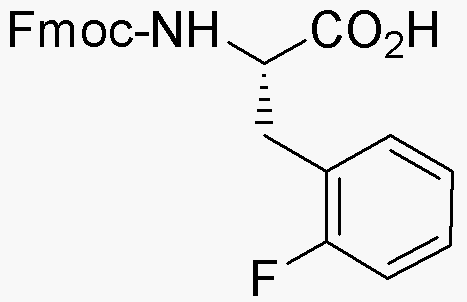Fmoc-2-fluoro-L-phenylalanine is widely utilized in research focused on
- Peptide Synthesis: This compound is a key building block in the synthesis of peptides, particularly in solid-phase peptide synthesis (SPPS), allowing for the incorporation of fluorinated amino acids which can enhance the properties of the resulting peptides.
- Drug Development: Its unique structure makes it valuable in the design of novel pharmaceuticals, especially in targeting specific receptors or enzymes, which can lead to more effective treatments with fewer side effects.
- Bioconjugation: The presence of the fluoro group allows for selective labeling and conjugation in biochemistry, facilitating the development of targeted therapies and diagnostic tools in medical research.
- Research in Protein Engineering: This compound is used to study the effects of fluorinated amino acids on protein folding and stability, providing insights into protein design and function.
- Analytical Chemistry: It serves as a useful standard in analytical methods for quantifying amino acids and peptides, improving accuracy in research and quality control in pharmaceutical manufacturing.
General Information
Properties
Safety and Regulations
Applications
Fmoc-2-fluoro-L-phenylalanine is widely utilized in research focused on
- Peptide Synthesis: This compound is a key building block in the synthesis of peptides, particularly in solid-phase peptide synthesis (SPPS), allowing for the incorporation of fluorinated amino acids which can enhance the properties of the resulting peptides.
- Drug Development: Its unique structure makes it valuable in the design of novel pharmaceuticals, especially in targeting specific receptors or enzymes, which can lead to more effective treatments with fewer side effects.
- Bioconjugation: The presence of the fluoro group allows for selective labeling and conjugation in biochemistry, facilitating the development of targeted therapies and diagnostic tools in medical research.
- Research in Protein Engineering: This compound is used to study the effects of fluorinated amino acids on protein folding and stability, providing insights into protein design and function.
- Analytical Chemistry: It serves as a useful standard in analytical methods for quantifying amino acids and peptides, improving accuracy in research and quality control in pharmaceutical manufacturing.
Documents
Safety Data Sheets (SDS)
The SDS provides comprehensive safety information on handling, storage, and disposal of the product.
Product Specification (PS)
The PS provides a comprehensive breakdown of the product’s properties, including chemical composition, physical state, purity, and storage requirements. It also details acceptable quality ranges and the product's intended applications.
Certificates of Analysis (COA)
Search for Certificates of Analysis (COA) by entering the products Lot Number. Lot and Batch Numbers can be found on a product’s label following the words ‘Lot’ or ‘Batch’.
Numéro de catalogue
Numéro de lot/série
Certificates Of Origin (COO)
This COO confirms the country where the product was manufactured, and also details the materials and components used in it and whether it is derived from natural, synthetic, or other specific sources. This certificate may be required for customs, trade, and regulatory compliance.
Numéro de catalogue
Numéro de lot/série
Safety Data Sheets (SDS)
The SDS provides comprehensive safety information on handling, storage, and disposal of the product.
DownloadProduct Specification (PS)
The PS provides a comprehensive breakdown of the product’s properties, including chemical composition, physical state, purity, and storage requirements. It also details acceptable quality ranges and the product's intended applications.
DownloadCertificates of Analysis (COA)
Search for Certificates of Analysis (COA) by entering the products Lot Number. Lot and Batch Numbers can be found on a product’s label following the words ‘Lot’ or ‘Batch’.
Numéro de catalogue
Numéro de lot/série
Certificates Of Origin (COO)
This COO confirms the country where the product was manufactured, and also details the materials and components used in it and whether it is derived from natural, synthetic, or other specific sources. This certificate may be required for customs, trade, and regulatory compliance.


